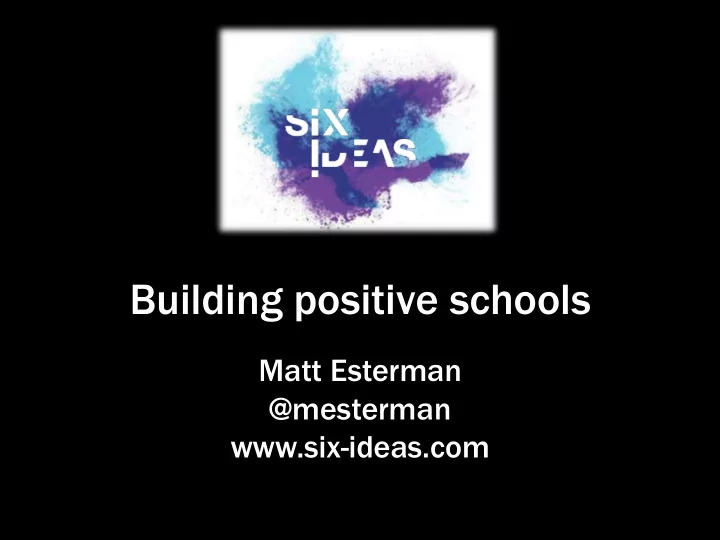

Building positive schools Matt Esterman @mesterman www.six-ideas.com
40,000 years of learning
This is not Pinterest.
What is your why?
Space > Function > People > Values Values > People > Function > Space This is a better WHY
What is school FOR in 2017?
80%
Assumption: school is the best place for learning “As many as 40% of school students are unproductive in a given year . Unproductive students are on average one to two years behind their peers, and their disengagement also damages their classmates and teachers .”
In teaching, you can’t do the Bloom stuff until you take care of the Maslow stuff. - Alan E. Beck
“ Wellbeing ” = keeping the rain off?
“ Wellbeing ” = keeping the rain off?
optimal spaces for stretch learning Vygotsky Zone of proximal development
bu but why y bot bother er ab abou out t the bu buildings? dings? We aren’t happy with what we’ve got
We asked (nearly) 100 people and...
Based on experience or evidence?
Based on experience or evidence?
School environments affect... Student attendance & drop out • rates • Student academic performance • Teacher retention • Social connections (F2F & virtual) • Physical health & mental health/wellbeing (Blackmore et al, 2011) • and more.
Where we are affects how we learn
Better classrooms boost learning by a year – “simple, quick effective” changes 153 classrooms 27 schools Salford University – Clever Classrooms
School buildings and facilities are one of the few contr ntrol ollable lable factor ors in learning… something we can actually do quite easily (at a cost) and that lasts - impact may not be huge in many studies, but it is proven to have an effect - Woolner
So what should we have?
Stretch zones Lenses not silos Learning that spills over walls Places that help make us better people
Intentionality in design for wellbeing
Does this already happen?
Fuji Kindergarten – run forever
Contemplative spaces
file:///.file/id=6571367.434 59023 High rise wellbeing Search “Arthur Phillip high rise”
Wellbeing for whom? ? ? Students Staff ? ? ? Parents/ Community Carers
Your stories: Small or large changes when creating places Share on Twitter using #PositiveSchools
How can we change our learning spaces next week? See differently, & speak differently.
Thornburg’s “primordial” metaphors
Fischer’s archetypes of spatial environments Delivering Applying Creating Communicating Decision Making
Prakash & Nair’s modalities of learning • Independent Study • Student presentation • Peer Tutoring • Performance or music based • Team collaborative work (2-6 learning S) • Seminar-style instruction • One-on-one learning (S+T) • Community service learning • Lecture format - Sage+stage • Naturalist learning • Project-based learning • Social/emotional learning • Mobile technology enhanced • Art-based learning • Distance learning • Storytelling • Internet-based research • Learning by building
Reconceptualise the school • Corridors as learning • Ceiling as projection streets screen • Playground as learning • Movement as key to laboratory learning • Nature as a • Writeable walls to sustainable teaching visualise learning resource • Tech as extension of • Windy days as space and time inspiration for creativity
Metacognition – thinking about learning: Learning aim > possible approaches > tools & resources > spaces
Rehearsing a play > individual reading + aloud > copy of play + recording device > cave/watering hole?
Some tips to take back to your school leaders
Planning = People + Purpose + Pedagogies + Parts + Place
Planning tips 1. Start with the values you wish to express 2. Accept that the building will outlast you 3. Think about tomorrow’s user 4. LISTEN, don’t just talk 5. Go outside the gates 6. Building(s) as an ongoing conversation 7. Talk about space(s) last 8. Work out who’s committed v who’s involved
Starting points Journal of Urban Design and Mental Health http://www.urbandesignmentalhealth.com/journal2- spatialdesign.html Your Classroom Is Making You Fail https://howwegettonext.com/your-classroom-is-making-you- fail-f3c9e8a986d3#.d5ofn7u8t Learning environment evaluation tool https://msd.unimelb.edu.au/post-occupancy-evaluation- learning-environments
Knowledge is knowing a tomato is a fruit. Wisdom is not putting a tomato in a fruit salad.
Make mental health & wellbeing a no non-nego negoti tiable able educational design principle.
Space > Function > People > Values Values > People > Function > Space
In a world of VUCA, schools can provide PLACE... Volatility People Uncertainty Learning Complexity Aspiration Ambiguity Community Engagement
What is your why?
Here’s my why. He will be 21 in 2037. What kind of world can we build for him?
Matthew Esterman @mesterman Matt.Esterman@six-ideas.com Join our community online at www.six-ideas.com
Recommend
More recommend